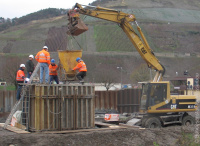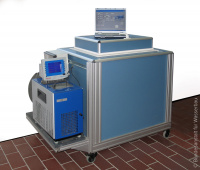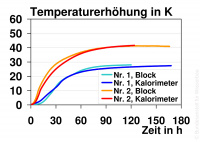Development of Hydration Heat in Concrete: Difference between revisions
From BAWiki
Created page with "The setting of concrete leads to the release of hydration heat which can result in a significant temperature increase, particularly in structural elements. This reaction cause..." |
No edit summary |
||
| Line 1: | Line 1: | ||
The setting of concrete leads to the release of hydration heat which can result in a significant temperature increase, particularly in structural elements. This reaction causes massive stresses which, in turn, may lead to the formation of cracks in the concrete. The resulting temperature difference developed in the process is of particular importance. | The setting of concrete leads to the release of hydration heat which can result in a significant temperature increase, particularly in structural elements. This reaction causes massive stresses which, in turn, may lead to the formation of cracks in the concrete. The resulting temperature difference developed in the process is of particular importance. | ||
The BAW's Supplementary Technical Contract Conditions for Hydraulic Engineering, Division 215 - Hydraulic Structures Made of Concrete or Reinforced Concrete ("Zusätzliche Technische Vertragsbedingungen - Wasserbau, Leistungsbereich 215 (ZTV-W LB 215)") account for this phenomenon by limiting the quasi adiabatic temperature increase in concrete and thus the resulting temperature in the structural component. The quasi adiabatic temperature increase is used in the assessment of thermal restraint due to hydration heat. | [[File:06_Hydrationswaermeentwicklung_01.jpg|200px|thumb|right|Picture 1: Manufacturing of the large-format concrete block for temperature measurements]]The BAW's Supplementary Technical Contract Conditions for Hydraulic Engineering, Division 215 - Hydraulic Structures Made of Concrete or Reinforced Concrete ("Zusätzliche Technische Vertragsbedingungen - Wasserbau, Leistungsbereich 215 (ZTV-W LB 215)") account for this phenomenon by limiting the quasi adiabatic temperature increase in concrete and thus the resulting temperature in the structural component. The quasi adiabatic temperature increase is used in the assessment of thermal restraint due to hydration heat. | ||
Various test methods are suitable for recording the temperature increase. They can generally be categorized into on-site tests on the one hand, and laboratory tests on the other hand. As a rule, contractors prove compliance with the requirements according to the ZTV-W LB 215 for concretes to be used in solid structural components by on-site temperature measurements performed on large-format insulated concrete blocks with an edge length of 2 m (picture 1). The provisions of the ZTV-W LB 215 detail the boundary conditions for the test. It can be assumed that this test set-up fullfils quasi adiabatic boundary conditions. It also takes account of the influences the manufacturing process has on the concrete, i.e. influences relating to production, transport and casting. | [[File:06_Hydrationswaermeentwicklung_02.jpg|200px|thumb|right|Picture 2: The BAW's adiabatic concrete calorimeter]]Various test methods are suitable for recording the temperature increase. They can generally be categorized into on-site tests on the one hand, and laboratory tests on the other hand. As a rule, contractors prove compliance with the requirements according to the ZTV-W LB 215 for concretes to be used in solid structural components by on-site temperature measurements performed on large-format insulated concrete blocks with an edge length of 2 m (picture 1). The provisions of the ZTV-W LB 215 detail the boundary conditions for the test. It can be assumed that this test set-up fullfils quasi adiabatic boundary conditions. It also takes account of the influences the manufacturing process has on the concrete, i.e. influences relating to production, transport and casting. | ||
In the BAW's construction materials laboratory the adiabatic temperature increase of concrete is measured - as part of the inspection tests performed by the client - with an adiabatic concrete calorimeter (picture 2). Such devices are not widely available on the market; the BAW currently has two devices that are the products of in-house development work. | [[File:06_Hydrationswaermeentwicklung_03.jpg|200px|thumb|right|Picture 3: Profile of the temperature development in a large-format concrete block and in the adiabatic concrete calorimeter]]In the BAW's construction materials laboratory the adiabatic temperature increase of concrete is measured - as part of the inspection tests performed by the client - with an adiabatic concrete calorimeter (picture 2). Such devices are not widely available on the market; the BAW currently has two devices that are the products of in-house development work. | ||
The concrete's temperature is recorded and evaluated over a 7-day period, both in the on-site test performed on the concrete block and in the adiabatic calorimeter (picture 3). | The concrete's temperature is recorded and evaluated over a 7-day period, both in the on-site test performed on the concrete block and in the adiabatic calorimeter (picture 3). | ||
Latest revision as of 12:08, 24 March 2022
The setting of concrete leads to the release of hydration heat which can result in a significant temperature increase, particularly in structural elements. This reaction causes massive stresses which, in turn, may lead to the formation of cracks in the concrete. The resulting temperature difference developed in the process is of particular importance.

The BAW's Supplementary Technical Contract Conditions for Hydraulic Engineering, Division 215 - Hydraulic Structures Made of Concrete or Reinforced Concrete ("Zusätzliche Technische Vertragsbedingungen - Wasserbau, Leistungsbereich 215 (ZTV-W LB 215)") account for this phenomenon by limiting the quasi adiabatic temperature increase in concrete and thus the resulting temperature in the structural component. The quasi adiabatic temperature increase is used in the assessment of thermal restraint due to hydration heat.

Various test methods are suitable for recording the temperature increase. They can generally be categorized into on-site tests on the one hand, and laboratory tests on the other hand. As a rule, contractors prove compliance with the requirements according to the ZTV-W LB 215 for concretes to be used in solid structural components by on-site temperature measurements performed on large-format insulated concrete blocks with an edge length of 2 m (picture 1). The provisions of the ZTV-W LB 215 detail the boundary conditions for the test. It can be assumed that this test set-up fullfils quasi adiabatic boundary conditions. It also takes account of the influences the manufacturing process has on the concrete, i.e. influences relating to production, transport and casting.

In the BAW's construction materials laboratory the adiabatic temperature increase of concrete is measured - as part of the inspection tests performed by the client - with an adiabatic concrete calorimeter (picture 2). Such devices are not widely available on the market; the BAW currently has two devices that are the products of in-house development work.
The concrete's temperature is recorded and evaluated over a 7-day period, both in the on-site test performed on the concrete block and in the adiabatic calorimeter (picture 3).
back to: Structural Engineering Methods
